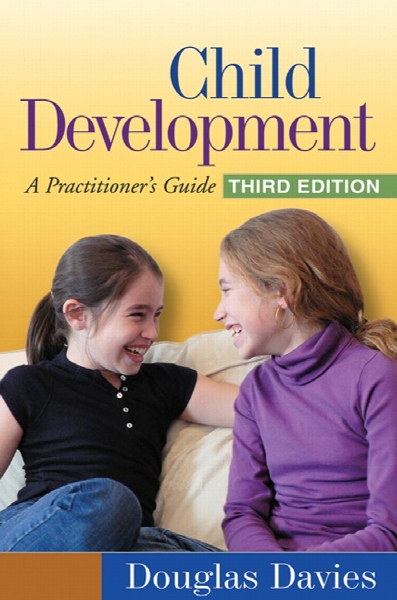Child development : a practitioner's guide,3rd ed
- نوع فایل : کتاب
- زبان : انگلیسی
- مؤلف : Douglas Davies
- ناشر : New York : Guilford Press
- چاپ و سال / کشور: 2011
- شابک / ISBN : 9781606239094
Description
PART I. Contexts of Development: A Tra nsac tional Approac h Introduction to Part I: Perspectives on Development 3 The Maturational Perspective, 3 The Transactional Model of Development, 4 Developmental Pathways and Intervention, 4 CHAPTER 1 Attachment as a Context of Development 7 How Attachment Develops, 8 Functions of Attachment, 8 Patterns of Attachment, 11 Attachment Classifications, 12 Attachment, Class, and Culture, 19 The Universality of Attachment, 21 Attachment and Future Development, 21 Parental Models of Attachment, 24 Attachment Theory and Family Systems Theory, 28 The Attachment Perspective in the Assessment of Young Children, 29 Kelly and Her Mother: A Case Example, 30 CHAPTER 2 Brain Development 39 Sequence of Brain Development, 40 Early Brain Growth: Synaptogenesis and Myelination, 40 Synaptic Overproduction and Pruning, 42 Plasticity and Experience, 43 Bonding, Attachment, and Brain Development, 43 Mirror Neurons and the Social Brain, 45 Can Parents Build Better Brains?, 46 Risk and Protective Factors Influencing Brain Development, 47 Stress, Trauma, and Brain Development, 49 Early Trauma and Brain Development, 51 Studies of Institutionally Deprived Young Children, 56 xvi C ontents CHAPTER 3 Risk and Protective Factors: The Child, Family, 60 and Community Contexts Research on Risk and Resilience, 60 Protective Factors and Processes, 61 Risk Factors, 65 Conclusion, 101 Appendix 3.1. Summary of Risk and Protective Factors, 103 CHAPTER 4 Analysis of Risk and Protective Factors: 105 Practice Applications How to Use Risk Factor Analysis, 105 Prediction of Risk: Assessing Current Risk and Protective Factors, 106 Retrospective Analysis of Risk and Protective Factors, 116 PART II. T he Course of Child Development Introduction to Part II: A Developmental Lens on Childhood 127 Barriers to Understanding the Child’s Perspective, 127 Dynamics of Developmental Change, 129 Interactions between Maturation and Environment, 129 Thinking Developmentally in Assessment and Intervention, 130 Organization of Developmental Chapters, 130 CHAPTER 5 Infant Development 131 The Interaction between Maturation and Caregiving, 131 Brain Development: The Importance of Early Experience, 132 Metaphors of Infant–Parent Transactions, 132 Caregivers’ Adaptations to Developmental Change, 133 The Neonatal Period: Birth–4 Weeks, 134 Age 1–3 Months, 137 Age 3–6 Months, 142 A Normal Infant and a Competent Parent: A Case Example, 147 Age 6–12 Months, 149 Appendix 5.1. Summary of Infant Development, Birth–12 Months of Age, 160 CHAPTER 6 Practice with Infants 163 Assessment Issues, 164 Assessment and Brief Interventions with an Infant and Her Family: A Case Example, 168 Observation Exercises, 183 C ontents xvii CHAPTER 7 T oddler Development 185 Physical Development, 186 Attachment and Secure Base Behavior, 186 Cognitive Development, 192 Language and Communication, 193 Symbolic Communication and Play, 200 Regulation of Emotion and Behavior, 203 Moral Development, 209 The Developing Self, 215 Appendix 7.1. Summary of Toddler Development, 1–3 Years of Age, 222 CHAPTER 8 Practice with Toddlers 225 Assessment, 225 Assessment of Toddler Development: A Case Example, 230 Intervention: Parent–Child Therapy, 244 Parent–Child Therapy with an Abused Toddler: A Case Example, 247 Observation Exercises, 249 Interview Exercise, 250 CHAPTER 9 Preschool Development 251 Physical Development, 252 Attachment, 254 Social Development, 256 Language Development, 262 Symbolic Communication and Play, 267 Cognitive Development, 270 Regulation of Emotion and Behavior, 279 Moral Development, 287 The Developing Self, 294 Appendix 9.1. Summary of Preschool Development, 3–6 Years of Age, 300 CHAPTER 10 Practice with Preschoolers 304 Assessment, 304 Child Care Consultation with a Preschool Child: A Case Example, 305 Intervention with Preschoolers: Play Therapy, 310 Using Play in the Treatment of Preschoolers, 312 Medical Treatment as a Developmental Interference, 313 Play Therapy with a Preschool Child: A Case Example, 315 Observation Exercise, 326 xviii C ontents CHAPTER 11 Middle Childhood Development 327 Physical Development, 328 The Transition from Preschool to Middle Childhood, 329 Attachment, 334 Social Development, 336 Language and Communication, 344 Play and Fantasy, 347 Cognitive Development, 350 Self-Regulation, 358 Moral Development, 365 Sense of Self, 367 Toward Adolescence, 378 Appendix 11.1. Summary of Middle Childhood Development, 6–12 Years of Age, 380 CHAPTER 12 Practice with School-Age Children 384 Assessment, 384 Intervention, 393 Working to Master the Trauma of Repeated Abuse: A Case Example, 398 Using Developmental Strengths: A Case Example, 406 Observation Exercises, 414 CHAPTER 13 C onclusion: Developmental Knowledge 415 and Practice Applying Practice Knowledge and Skills, 416 Ever-Present Complications in Practice, 417 Intervention and Developmental Outcome, 419
Previous ed.: 2004.


